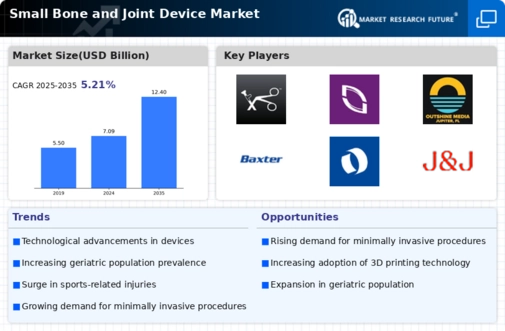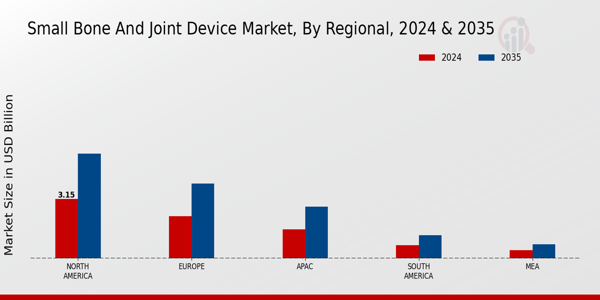Market Growth Projections
The Global Small Bone and Joint Device Market Industry is poised for substantial growth, with projections indicating a market value of 12.4 USD Billion by 2035. This growth trajectory suggests a compound annual growth rate of 5.21% from 2025 to 2035. The increasing demand for orthopedic devices, driven by factors such as technological advancements and an aging population, is likely to sustain this upward trend. The market's expansion is supported by ongoing innovations and a focus on improving patient outcomes, positioning the industry for a robust future.
Rising Healthcare Expenditure
An increase in global healthcare expenditure is positively impacting the Global Small Bone and Joint Device Market Industry. Governments and private sectors are investing more in healthcare infrastructure, leading to improved access to orthopedic care. This trend is particularly evident in emerging economies, where rising disposable incomes allow for greater healthcare spending. Enhanced funding for research and development in orthopedic devices is also a direct result of this increased expenditure. As healthcare systems evolve, the market is likely to benefit from a growing focus on innovative treatment options, further driving the demand for small bone and joint devices.
Technological Advancements in Device Design
Innovations in technology are significantly influencing the Global Small Bone and Joint Device Market Industry. Advanced materials, such as biocompatible polymers and improved fixation devices, enhance the performance and longevity of orthopedic implants. These advancements not only improve patient outcomes but also reduce recovery times. The integration of smart technologies, such as sensors in joint devices, is also emerging, providing real-time data for better patient management. As these technologies evolve, they are expected to contribute to a compound annual growth rate of 5.21% from 2025 to 2035, indicating a robust future for the industry.
Increasing Incidence of Orthopedic Disorders
The Global Small Bone and Joint Device Market Industry is experiencing growth due to the rising prevalence of orthopedic disorders. Conditions such as arthritis and osteoporosis are becoming more common, particularly among the aging population. In 2024, the market is valued at 7.09 USD Billion, reflecting the demand for effective treatment solutions. The increasing number of surgical procedures related to small bones and joints further drives this market. As healthcare systems adapt to these challenges, the industry is likely to expand, with projections indicating a market value of 12.4 USD Billion by 2035.
Aging Population and Increased Life Expectancy
The aging population is a significant driver of the Global Small Bone and Joint Device Market Industry. As life expectancy increases, the incidence of age-related orthopedic conditions rises, necessitating effective treatment solutions. Older adults are more susceptible to fractures and joint disorders, leading to a higher demand for small bone and joint devices. This demographic shift is particularly pronounced in developed countries, where healthcare systems are adapting to cater to the needs of an aging population. As the market evolves, it is expected to see sustained growth, aligning with the projected market value of 12.4 USD Billion by 2035.
Growing Demand for Minimally Invasive Procedures
The trend towards minimally invasive surgical techniques is reshaping the Global Small Bone and Joint Device Market Industry. Patients increasingly prefer procedures that offer reduced recovery times and lower risks of complications. This shift is prompting manufacturers to develop devices that facilitate such techniques, leading to a broader range of options for healthcare providers. The market's growth is further supported by the increasing number of training programs for surgeons in minimally invasive techniques. As these procedures become more commonplace, the demand for specialized small bone and joint devices is expected to rise, contributing to the overall market expansion.











